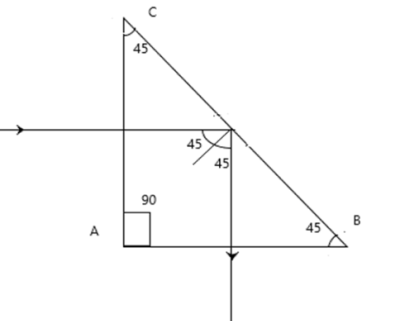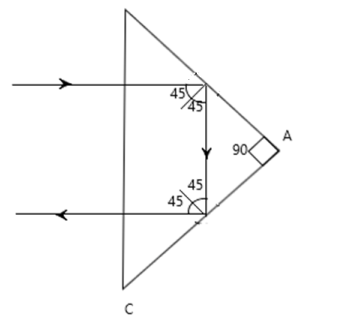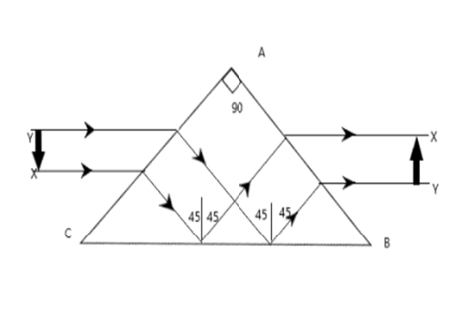
Total reflecting prism is used for
A. deviating a ray of light through
B. deviating a ray of light through
C. Obtaining an indented image without producing deviation in the path.
D. All of these
Answer
587.4k+ views
Hint: Recall the laws of reflection, refraction along normal. Use angle of incident= angle of reflection. Apply total internal reflection of the light rays to solve the above given problem.
Complete Step-by-Step solution:
As we all know prism is a transparent object which allows the light rays to pass through it. You have already conducted experiments with prism in your class 10. Most of the prisms have a triangular base and we can see reflection, refraction and dispersion of the light with help of a prism.
When a light ray travels from medium to another and if it is completely reflected back to the first medium without undergoing refraction, it is called total reflection. The total reflecting prism is designed in such a way that it has two reflecting surfaces and one non reflecting surface (base). The angle between the two reflecting surfaces is and angle to it opposite are respectively.
The main applications of these prisms are
1. Used in deviating the direction of light rays by

The procedure is very simple. The incident ray is allowed to fall normally on one of the reflecting surfaces. As we can see in the figure the incident ray will strike on the non reflecting surface at angle of. The reflected ray emerges back without any refraction in a direction perpendicular to the incident ray.
2. Used in deviating the direction of light rays by

The perpendicularly incidental ray undergoes total internal reflection twice and emerges out in the opposite direction of the incident ray. The angle between the incident and the emerged ray is.
3. Used to get erected image of the inverted object without deviating its path

The inverted object is placed in front of the prism. The light rays from the object which are parallel to the base of the prism are allowed to pass through the prism. Each ray of light will undergo refraction twice at the two reflecting surfaces and one reflection at the base of the prism. Then the emerging beam of light will be an erected image of the object.
So in conclusion these three are the applications of the total reflecting prism. Thus option D is the answer.
Note: In the first case and second case since the incident rays were passing through the normal there was no refraction. But in the third case, the incident rays were not passing normally to the surface of the prism hence each ray undergoes refraction.
Complete Step-by-Step solution:
As we all know prism is a transparent object which allows the light rays to pass through it. You have already conducted experiments with prism in your class 10. Most of the prisms have a triangular base and we can see reflection, refraction and dispersion of the light with help of a prism.
When a light ray travels from medium to another and if it is completely reflected back to the first medium without undergoing refraction, it is called total reflection. The total reflecting prism is designed in such a way that it has two reflecting surfaces and one non reflecting surface (base). The angle between the two reflecting surfaces is and angle to it opposite are respectively.
The main applications of these prisms are
1. Used in deviating the direction of light rays by

The procedure is very simple. The incident ray is allowed to fall normally on one of the reflecting surfaces. As we can see in the figure the incident ray will strike on the non reflecting surface at angle of. The reflected ray emerges back without any refraction in a direction perpendicular to the incident ray.
2. Used in deviating the direction of light rays by

The perpendicularly incidental ray undergoes total internal reflection twice and emerges out in the opposite direction of the incident ray. The angle between the incident and the emerged ray is.
3. Used to get erected image of the inverted object without deviating its path

The inverted object is placed in front of the prism. The light rays from the object which are parallel to the base of the prism are allowed to pass through the prism. Each ray of light will undergo refraction twice at the two reflecting surfaces and one reflection at the base of the prism. Then the emerging beam of light will be an erected image of the object.
So in conclusion these three are the applications of the total reflecting prism. Thus option D is the answer.
Note: In the first case and second case since the incident rays were passing through the normal there was no refraction. But in the third case, the incident rays were not passing normally to the surface of the prism hence each ray undergoes refraction.
Recently Updated Pages
Master Class 12 Business Studies: Engaging Questions & Answers for Success

Master Class 12 Economics: Engaging Questions & Answers for Success

Master Class 12 English: Engaging Questions & Answers for Success

Master Class 12 Maths: Engaging Questions & Answers for Success

Master Class 12 Social Science: Engaging Questions & Answers for Success

Master Class 12 Chemistry: Engaging Questions & Answers for Success

Trending doubts
Who was the first woman to receive Bharat Ratna?

Write a letter to the principal requesting him to grant class 10 english CBSE

Why is there a time difference of about 5 hours between class 10 social science CBSE

What is the median of the first 10 natural numbers class 10 maths CBSE

The Equation xxx + 2 is Satisfied when x is Equal to Class 10 Maths

Discuss the main reasons for poverty in India




